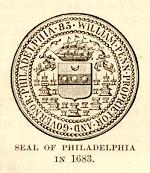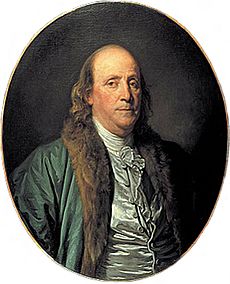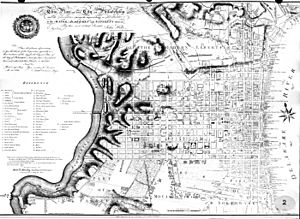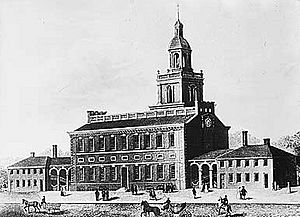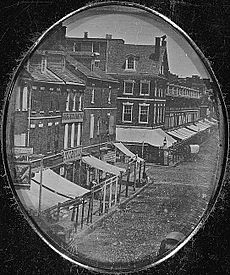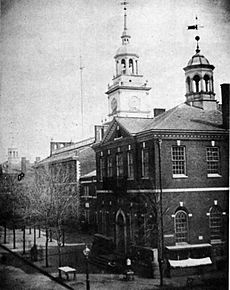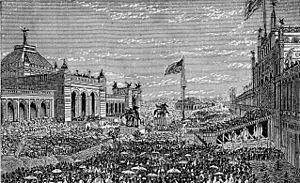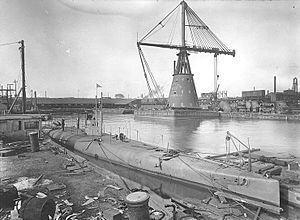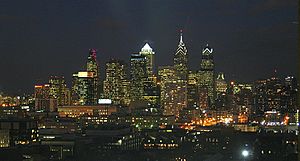History of Philadelphia facts for kids
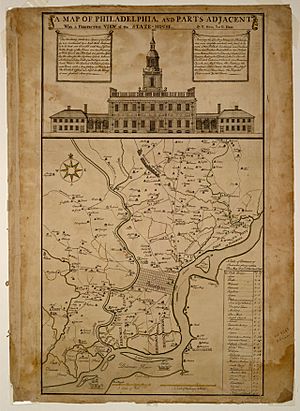
The history of Philadelphia began in 1682. That's when William Penn founded the city. It was part of the Province of Pennsylvania, a land given to him by the King of England. Philadelphia is located between the Delaware River and Schuylkill River.
Before Penn arrived, the Lenape people lived in this area. Philadelphia quickly became an important city in the Thirteen Colonies. During the American Revolutionary War, it hosted the Continental Congress. After the Revolution, Philadelphia was the temporary capital of the United States.
In the early 1800s, the government left Philadelphia. But the city remained a major center for culture and money. It became one of the first industrial cities in the U.S., known for its textile factories.
After the American Civil War, a powerful political group controlled Philadelphia's government. By the early 1900s, some called the city "corrupt and contented." Over time, new rules changed the city government. A big change in 1950 made the mayor stronger and the Philadelphia City Council weaker. Around the same time, people in Philadelphia started supporting the Democratic Party more than the Republican Party.
In the 1950s, Philadelphia's population began to shrink. Many white, middle-class families moved to the suburbs. Many houses in the city were old and in poor condition. There were also problems with gangs. But later, efforts to fix up neighborhoods brought people back. In the 1990s and early 2000s, new projects and benefits improved the city's image. This led to a boom in new homes in Center City, which helped slow the population decline.
Contents
- Founding Philadelphia
- Early Growth and Challenges
- Revolutionary Times
- Temporary Capital and Challenges
- Industrial Growth and Changes
- Late 19th Century Philadelphia
- Early 20th Century and World War I
- Great Depression and World War II
- After World War II: Reform and Change
- Philadelphia in the 21st Century
- Images for kids
Founding Philadelphia
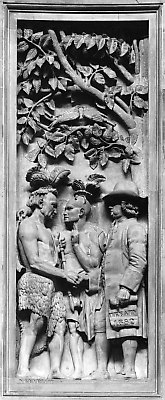
In 1681, King Charles II of England gave William Penn a large piece of land in America. This was to pay back a debt the king owed Penn's father. This land became Pennsylvania and Delaware. Penn then organized a trip to America. He first arrived in New Castle, Delaware. The people there accepted him as their new leader.
Penn then traveled up the river. He founded Philadelphia with a group of Quakers and others seeking religious freedom. He bought the land from the local Lenape chiefs. This started a long time of peace between the colonists and the Lenape.
Other European groups had settled in the area before Penn. Swedish settlers arrived in the early 1600s and founded New Sweden. The Dutch also had claims. But the English eventually took control.
Philadelphia quickly grew into an important city. It became a major port for trade. During the American Revolutionary War, Philadelphia was a key meeting place. The Continental Congress met here. The Declaration of Independence was also signed in Philadelphia in July 1776.
After the Revolution, Philadelphia was the temporary capital of the United States from 1790 to 1800.
Early Growth and Challenges
William Penn wanted Philadelphia to be a peaceful city. He imagined a place where people of all religions could live and worship freely. Penn, being a Quaker, had faced religious unfairness himself. He also planned the city with a grid of streets, like a country town, not a crowded city. He wanted homes to have gardens. He named the city Philadelphia, which means "brotherly love."
Penn sent people to choose the best spot and lay out the city. They bought land from the Swedes and started building. The city stretched about a mile along the Delaware River. Penn himself arrived in October 1682. He expanded the city westward to the Schuylkill River. Streets were laid out in a grid. Main streets were named after trees, and others were numbered. Four public parks were also set aside.
At first, some settlers lived in caves along the river. But the city quickly grew with new homes, churches, and docks. Most people wanted to live close to the Delaware River, so the city became more crowded than Penn had planned.
Philadelphia grew from a few hundred people in 1683 to over 2,500 by 1701. The population included English, Welsh, Irish, Germans, Swedes, Finns, Dutch, and African slaves. In 1701, William Penn gave Philadelphia a special document called the Charter of 1701. This made Philadelphia an official city and gave its leaders the power to make laws.
Philadelphia became a major trading port. It traded a lot with the Caribbean. However, wars and economic problems sometimes slowed the city's growth. In the 1720s and 1730s, many immigrants from Germany and Ireland arrived. This helped the region grow in farming, and Philadelphia exported goods like grains and lumber.
Philadelphia's promise of religious freedom attracted many different groups. Soon, Quakers were outnumbered by others like Mennonites, Anglicans, and Catholics. Even though Quakers were a smaller group, they remained important in business and politics.
In the early 1700s, Philadelphia was quite dirty. Roads were unpaved and often muddy. But by the 1750s, it started to become a major city. Important buildings like Christ Church and Independence Hall were built. Streets were paved and lit with oil lamps. The city's first newspaper began publishing in 1719.
Philadelphia also grew in culture and science. Schools, libraries, and theaters were founded. Benjamin Franklin arrived in Philadelphia in 1723. He played a huge role in the city's development. Franklin helped start the first fire company, improved postal routes, and helped build the American colonies' first hospital in 1752. He also helped found the College of Philadelphia.
Revolutionary Times
In the 1760s, the British government passed new laws like the Stamp Act. These laws made colonists angry. Philadelphia residents joined boycotts of British goods. After the Tea Act in 1773, people in Philadelphia stopped a ship from unloading tea, similar to the Boston Tea Party.
In 1774, activists called for a meeting of all the colonies. They agreed to meet in Philadelphia. The First Continental Congress was held in September at Carpenters' Hall. When the American Revolutionary War began in April 1775, the Second Continental Congress met in May at the Pennsylvania State House. A year later, they wrote and signed the Declaration of Independence there in July 1776.
Philadelphia was very important to the war effort. It was a central city with a lot of trade and skilled workers. Because it was a port city, it was open to attack by the British navy. In December 1776, fear of invasion caused half of the city's population to flee. The Continental Congress moved to Baltimore. But George Washington pushed back the British, and people returned.
In September 1777, the British invaded Philadelphia from the south. Washington tried to stop them but failed. Thousands more people fled. British troops marched into Philadelphia on September 23. They were cheered by people who supported the British King.
The British stayed for ten months. After France joined the war to help the Americans, the British left Philadelphia on June 18, 1778. American troops returned the same day. The city government and Congress also came back.
During the war, there was a lot of inflation, which made things expensive, especially for the poor. This led to some unrest. In October 1779, a riot broke out where people attacked James Wilson, a signer of the Declaration of Independence, who they thought supported the British.
Temporary Capital and Challenges
After the war, the U.S. Congress moved out of Philadelphia for a short time. But in 1790, Philadelphia was chosen to be the temporary capital of the United States for ten years. Congress met in what became known as Congress Hall. The Supreme Court met at City Hall. President Washington lived in a house at 6th and Market Street.
Yellow Fever Epidemic
After 1787, Philadelphia's economy grew quickly. However, serious yellow fever outbreaks in the 1790s caused problems. In August 1793, a yellow fever epidemic began. It lasted four months. Thousands of refugees from Saint-Domingue (now Haiti) had recently arrived. They likely carried the disease, which spread quickly through mosquito bites.
Fear caused 20,000 residents to flee the city. Trade almost stopped. Other cities put people and goods from Philadelphia in quarantine. The fever finally ended in October when the weather got colder. Between 4,000 and 5,000 people died out of a population of 50,000.
Slavery and Freedom
Pennsylvania had ended slavery in 1780. This meant any enslaved people brought to the city had to be freed after six months. This law was challenged by French refugees from Saint-Domingue who brought enslaved people with them. But the Pennsylvania Abolition Society fought for their freedom. By 1796, 500 enslaved people from Saint-Domingue gained their freedom in Philadelphia.
During Philadelphia's time as the capital, members of Congress could keep enslaved people. But other government officials could not. President Washington and others brought enslaved people as servants. They avoided the law by moving their enslaved people out of the city before the six-month deadline. Two of Washington's enslaved people escaped from his house. He eventually replaced his enslaved workers with German indentured servants.
Industrial Growth and Changes
The state government left Philadelphia in 1799, and the U.S. government left in 1800. By then, Philadelphia was the largest city in the country. Its busy port was a major center for trade. However, trade was interrupted by the Embargo Act of 1807 and the War of 1812. After the war, New York City became the busiest port and largest city.
The decrease in foreign trade led Philadelphia to build its own factories. Manufacturing plants and foundries were built. Philadelphia became important for making paper, leather, shoes, and boots. New roads, canals, and railroads helped Philadelphia's factories grow. The city became the first major industrial city in the United States.
Important projects included the Fairmount Water Works, iron water pipes, and the U.S. Naval Yard. In 1835, about 20,000 Philadelphia workers went on strike. This was the first general strike in North America. They won a ten-hour workday and higher wages.
Besides its factories, Philadelphia was also the financial center of the country. It was home to the First and Second Banks of the United States, and the first U.S. Mint. Cultural places like the Pennsylvania Academy of the Fine Arts and the Franklin Institute also grew. In 1834, a law created the public school system.
Late 19th Century Philadelphia
After the Civil War, Philadelphia's population kept growing. It went from 565,529 people in 1860 to 817,000 by 1876. The city grew north, south, and westward across the Schuylkill River. Many new residents were immigrants, mostly from Ireland and Germany. By 1870, about 27% of Philadelphia's population was born outside the U.S.
In 1854, a law called the Act of Consolidation made the city of Philadelphia include the entire county. This meant all smaller towns became part of the city.
By the 1880s, more immigrants came from Russia, Eastern Europe, and Italy. Many from Russia and Eastern Europe were Jewish. Philadelphia's Italian population also grew a lot, with most settling in South Philadelphia. Also, many African Americans moved from the South to Philadelphia. By 1876, nearly 25,000 African Americans lived in the city.
Politically, the Republican Party controlled the city. They had a strong political system that gained power through favors and sometimes voter fraud. However, some government changes did happen. The police department was reorganized, and paid firefighters replaced volunteers. A law in 1895 made school attendance required. Higher education also changed, with the University of Pennsylvania moving and new universities like Temple University and Drexel University being founded.
A major event for the city was hosting the Centennial Exposition in 1876. This was the first World's Fair in the United States. It celebrated 100 years of the nation's independence. Over nine million people visited the fair. The city also began building a new city hall, which took 23 years to complete. When finished in 1884, it was the tallest building in Philadelphia for nearly 100 years.
Philadelphia's main industries were the Baldwin Locomotive Works (making trains), William Cramp and Sons Ship and Engine Building Company (building ships), and the Pennsylvania Railroad. The city also had many iron and steel factories. The largest industry was textiles. In 1904, the textile industry employed over 35% of the city's workers. Other strong industries included cigars, sugar, and oil. Large department stores like Wanamaker's and Gimbels also opened on Market Street.
Early 20th Century and World War I
In the early 1900s, Philadelphia had a reputation for being dull and politically corrupt. The Republican political system controlled most parts of the city government. People estimated that millions of dollars were wasted each year due to dishonest practices. In 1905, the city tried to make election reforms, but the political bosses remained in control.
Philadelphia continued to grow with immigrants from Eastern Europe and Italy, and African American migrants from the South. World War I briefly stopped foreign immigration. The war created a high demand for workers in the city's factories, including the new U.S. Naval Yard. This demand helped attract many African Americans during the Great Migration.
In September 1918, the influenza pandemic began to spread in Philadelphia. Thousands of people died. By the time it ended in October, over 12,000 people had died.
The growing popularity of cars led to big changes in the city. Roads were widened, and new roads like Northeast (Roosevelt) Boulevard were built. Many streets became one-way. The Benjamin Franklin Bridge to New Jersey opened in 1926. Philadelphia began to modernize with new skyscrapers and electricity. The city's first subway line opened in 1907. In 1928, the Philadelphia Museum of Art opened.
Great Depression and World War II
After the stock market crashed in 1929, many Philadelphia banks closed. From 1929 to 1933, manufacturing in the region fell by 45 percent. Factory jobs fell by 60 percent. Unemployment was highest in 1933. The mayor at the time, J. Hampton Moore, fired city workers and cut pay to save money. This kept the city from going bankrupt but was unpopular.
Later, Mayor S. Davis Wilson started many programs funded by President Franklin D. Roosevelt's New Deal. These programs created jobs for thousands of Philadelphians.
During the 1930s, the Democratic Party grew stronger in Philadelphia. This was partly because of Roosevelt's leadership during the Depression. In 1936, the Democratic National Convention was held in Philadelphia. Voters in the city supported Roosevelt and other Democrats.
The start of World War II in Europe created new jobs in defense industries. After the U.S. joined the war in 1941, Philadelphia helped a lot. Many residents served in the military. With so many men away, businesses hired women and workers from outside the city. In 1944, African Americans were promoted to new roles on public transportation. This led to a strike by other workers, which almost stopped the city. President Roosevelt sent troops to help, and the workers returned after six days.
After World War II: Reform and Change
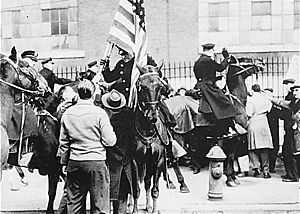
After World War II, Philadelphia faced a housing shortage. Many homes were old and in poor condition. As African Americans and Puerto Ricans moved into new neighborhoods, there was some tension. Wealthier middle-class residents, often white, continued to move to the suburbs. This was called "white flight."
Philadelphia's population peaked at over two million in 1950. After that, the city's population declined as jobs in factories and railroads decreased. The city lost many jobs as industries changed.
The city encouraged new building projects. They removed an old elevated railway and developed areas around University City and Temple University. Some historic neighborhoods like Society Hill were restored, attracting people back. The airport expanded, and new highways like the Schuylkill Expressway were built.
In the 1960s, Philadelphia, like other U.S. cities, saw many protests. There were civil rights protests and anti-war protests. A riot in 1964 caused injuries and damage. Crime was also a serious problem. By the end of the 1980s, the city was almost bankrupt.
Philadelphia in the 21st Century
In 1992, Edward Rendell was elected mayor. At that time, the city had many unpaid bills and a large budget deficit. Rendell worked to attract new businesses and stabilize the city's money. He created small budget surpluses.
Revitalization of parts of Philadelphia continued in the 1990s. A new convention center opened in 1993, leading to many new hotels. The city started promoting its history and holding festivals to attract tourists. In 2005, National Geographic Traveler called Philadelphia "America's Next Great City."
John F. Street became mayor in 1999. City improvements continued. His administration focused on fixing up some of the city's toughest neighborhoods. Tax breaks helped create a boom in new homes in Center City. This increased the population of Center City and helped slow the city's population decline.
In 2008, Michael Nutter was elected mayor. He helped decrease the crime rate. Tourism became one of the city's main industries. Philadelphia is now one of the most visited cities in the U.S. Nutter also started a program to help prevent home foreclosures, which other cities have copied.
In 2015, Pope Francis visited Philadelphia as part of his trip to the United States. He attended the World Meeting of Families and gave a mass to a crowd of one million people on the Benjamin Franklin Parkway. He also spoke at Independence Hall.
Images for kids
-
The European forts and settlements in the Delaware River Valley, then known as New Sweden, ca. 1650.
-
This 1683 map of Philadelphia is believed to be the first city map created
-
A nativist riot in Southwark, July 7, 1844
-
USS G-4 at the William Cramp & Sons shipyard in Philadelphia, October 2, 1912
-
George Floyd protests in Philadelphia, June 2, 2020


